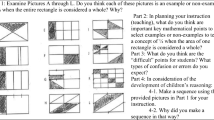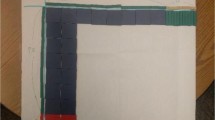Abstract
This study investigated 111 pre-service teachers’ (PSTs’) flexibility with referent units in solving a fraction division problem using a length model. Participants’ written solutions to a measurement fraction division problem were analyzed in terms of strategies and types of errors, using an inductive content analysis approach. Findings suggest that most PSTs could calculate fraction division and make equivalent fractions procedurally but did not have the quantitative meanings of measurement division with fraction quantities or of making equivalent fractions. Implications are discussed for the improvement of PSTs’ specialized knowledge for teaching fraction division.













Similar content being viewed by others
Notes
This ability is related to norming, which is described as “the process of reconceptualzing a system in relation to some fixed unit or standard” (Lamon, 1994, p. 94) – more specifically – identifying the standard unit with which to measure and representing quantities of an object with the unit.
According to Star (2005), deep procedural knowledge is defined as “knowledge of procedures that is associated with comprehension, flexibility, and critical judgment and that is distinct from (but possibly related to) knowledge of concepts” (p. 408).
This is one among many possible ways to help PSTs think about why the invert and multiply strategy works.
References
Ball, D. L. (1990). Prospective elementary and secondary teachers’ understanding of division. Journal for Research in Mathematics Education, 21(2), 132–144.
Borko, H., Eisenhart, M., Brown, C., Underhill, R., Jones, D., & Agard, P. (1992). Learning to teach hard mathematics: Do novice teachers and their instructors give up too easily? Journal for Research in Mathematics Education, 23(3), 194–222.
Carraher, D. W., Schliemann, A. D., & Schwartz, J. L. (2008). Early algebra is not the same as algebra early. In J. J. Kaput, D. W. Carraher, & M. L. Blanton (Eds.), Algebra in the early grades (pp. 235–272). New York: Lawrence Erlbaum.
Common Core State Standards Initiative [CCSSI]. (2010). Common core state standards for mathematics. Washington, DC: National Governors Association Center for Best Practices and the Council of Chief State School Officers. Retrieved February 21, 2017, http://corestandards.org/assets/CCSSI_Math%20Standards.pdf
Creswell, J. (2014). Research design: Qualitative, quantitative, and mixed methods approaches (4th ed.). Thousand Oaks: SAGE.
Grbich, C. (2007). Qualitative data analysis: An introduction. London: SAGE Publications.
Hackenberg, A. J. (2013). The fractional knowledge and algebraic reasoning of students with the first multiplicative concept. Journal of Mathematical Behavior, 32(3), 538–563.
Hackenberg, A. J., & Lee, M. Y. (2015). Relationships between students’ fractional knowledge and equation writing. Journal for Research in Mathematics Education, 46(2), 196–243.
Hill, H. C., Ball, D. L., & Schilling, S. G. (2008). Unpacking pedagogical content knowledge: Conceptualizing and measuring teachers’ topic-specific knowledge of students. Journal for Research in Mathematics Education, 39(4), 372–400.
Isiksal, M., & Cakiroglu, E. (2011). The nature of prospective mathematics teachers’ pedagogical content knowledge: The case of multiplication of fractions. Journal of Mathematics Teacher Education, 14(3), 213–230.
Izsák, A. (2008). Mathematical knowledge for teaching fraction multiplication. Cognition and Instruction, 26(1), 95–143.
Jacobs, V. R., & Empson, S. B. (2016). Responding to children’s mathematical thinking in the moment: An emerging framework of teaching moves. ZDM Mathematics Education, 48(1), 185-197. doi:10.1007/s11858-015-0717-0
Jacobson, E., & Izsák, A. (2015). Knowledge and motivation as mediators in mathematics teaching practice: The case of drawn models for fraction arithmetic. Journal of Mathematics Teacher Education, 18(5), 467–488.
Jansen, A., & Hohensee, C. (2016). Examining and elaborating upon the nature of elementary prospective teachers’ conceptions of partitive division with fractions. Journal of Mathematics Teacher Education, 19(6), 503–522.
Lamon, S. (1994). Ratio and proportion: Cognitive foundations in unitizing and norming. In G. Harel & J. Confrey (Eds.), The development of multiplicative reasoning in the learning of mathematics (pp. 89–120). Albany: State University Press of New York.
Lee, S. J., Brown, R. E., & Orrill, C. H. (2011). Mathematics teachers’ reasoning about fractions and decimals using drawn representations. Mathematical Thinking and Learning, 13(3), 198–220.
Lee, M. Y., & Hackenberg, A. J. (2014). Relationships between fractional knowledge and algebraic reasoning: The case of Willa. International Journal of Science and Mathematics Education, 12(4), 975–1000. doi:10.1007/s10763-013-9442-8
Lo, J. J., & Luo, F. (2012). Prospective elementary teachers’ knowledge of fraction division. Journal of Mathematics Teacher Education, 15(6), 481–500.
Ma, L. (1999). Knowing and teaching elementary mathematics: Teachers’ understanding of fundamental mathematics in China and the United States. Mahwah: Lawrence Erlbaum.
National Council of Teachers of Mathematics [NCTM]. (2000). Principles and standards for school mathematics. Reston: Author.
National Council of Teachers of Mathematics [NCTM]. (2014). Principles to actions: Ensuring mathematical success for all. Reston: Author.
National Mathematics Advisory Panel [NMAP]. (2008). The Final Report of the National Mathematics Advisory Panel. Retrieved January 17, 2017, from http://www2.ed.gov/about/bdscomm/list/mathpanel/report/final-report.pdf
Norton, A., & Wilkins, J. L. M. (2009). A quantitative analysis of children’s splitting operations and fraction schemes. Journal of Mathematical Behavior, 28(2–3), 150–161.
Olanoff, D., Lo, J., & Tobias, J. (2014). Mathematical content knowledge for teaching elementary mathematics: A focus on fractions. The Mathematics Enthusiast, 11(2), 267–310.
Rosli, R., Han, S., Capraro, R., & Capraro, M. (2013). Exploring preservice teachers’ computational and representational knowledge of content and teaching fractions. Journal of Korean Society of Mathematics Education, 17(4), 221–241.
Shulman, L. S. (1986). Those who understand: Knowledge growth in teaching. Educational Researcher, 15(2), 4–14.
Smith, J. P., & Thompson, P. W. (2008). Quantitative reasoning and the development of algebraic reasoning. In J. J. Kaput, D. W. Carraher, & M. L. Blanton (Eds.), Algebra in the early grades (pp. 95–132). New York: Lawrence Erlbaum.
Son, J. W., & Crespo, S. (2009). Prospective teachers’ reasoning and response to a student’s non-traditional strategy when dividing fractions. Journal of Mathematics Teacher Education, 12(4), 235–261.
Sowder, J., Philipp, R., Armstrong, B., & Schappelle, B. (1998). Middle-grade teachers’ mathematical knowledge and its relationship to instruction: A research monograph. Albany: State University of New York Press.
Steffe, L. P. (2002). A new hypothesis concerning children’s fractional knowledge. Journal of Mathematical Behavior, 20(3), 267–307.
Steffe, L. P., & Olive, J. (2010). Children’s fractional knowledge. New York: Springer.
Thompson, P. W. (1993). Quantitative reasoning, complexity, and additive structures. Educational Studies in Mathematics, 25(3), 165–208.
Thompson, P. W. (1995). Notation, convention, and quantity in elementary mathematics. In J. T. Sowder & B. P. Schappelle (Eds.), Providing a foundation for teaching mathematics in the middle grades (pp. 199–219). Albany: State University of New York Press.
Tirosh, D. (2000). Enhancing prospective teachers’ knowledge of children’s conceptions: The case of division of fractions. Journal for Research of Mathematics Education, 31(1), 5–25.
Acknowledgements
An earlier version of this paper was presented at the NIMS (National Institute for Mathematical Sciences) and KSME (The Korean Society of Mathematical Education) International Workshop in 2017.
Author information
Authors and Affiliations
Corresponding author
Rights and permissions
About this article
Cite this article
Lee, M.Y. Pre-service teachers’ flexibility with referent units in solving a fraction division problem. Educ Stud Math 96, 327–348 (2017). https://doi.org/10.1007/s10649-017-9771-6
Published:
Issue Date:
DOI: https://doi.org/10.1007/s10649-017-9771-6




